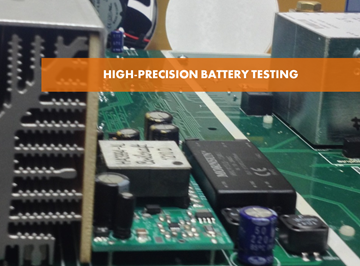Ford Motor Company (AMPED)
DEVELOPING A HIGH PRECISION BATTERY TESTING DEVICE
UPDATED: FEBRUARY 24, 2016
PROJECT TITLES: High-Precision Tester for Automotive and Stationary Batteries
PROGRAM: AMPED
AWARD: $3,128,000
PROJECT TEAM: Ford Motor Company (Lead); Arbin Instruments; Sandia National Laboratory; Montana Tech University
PROJECT TERM: January 2013 – March 2016
TECHNICAL CHALLENGE
To meet the performance, lifetime, and cost requirements for electric vehicles and grid-scale energy storage, significant continuing advances in battery technology are required. One barrier to progress is the length of time required to test the properties of a new battery design. Standard lifetime prediction methods with state-of-the-art testers typically require 10-30% of the battery's intended life to be tested. While these turn-around times are acceptable for batteries for consumer electronics (with one year required lifetimes), they are too slow for automotive and stationary energy storage applications (with 10-30 year required lifetimes). A better battery tester capable of faster lifetime prediction would thus reduce the time and cost associated with developing future battery systems.
TECHNICAL OPPORTUNITY
The key opportunity for battery testing technology is the recognition that lifetime prediction can be greatly improved with increased measurement precision. However, better battery testing devices for transportation and stationary energy storage face the challenge of achieving precise measurements under the difficult conditions associated with high-current testing, where transients in temperature and in electrical signals affect the stability of measurements. High-precision testing for large, high-power batteries requires new approaches to circuit design, advanced materials for stability in measurement, and expertise in calibration.

INNOVATION DEMONSTRATION
Researchers within Ford Motor Company established a collaboration with Arbin Instruments, Sandia National Lab, and Montana Tech University to develop the application of high-precision testing to meaningful load profiles and larger capacity batteries employed in real-world applications. Their project includes the design, build, calibration and evaluation of a battery tester with the goal of an 8X improvement in voltage measurement precision and 4X improvement in current measurement precision over today’s leading testers. The project team’s key enabler was its innovative circuit design and thermal management approach to reduce noise and maintain stability. These system design innovations were integrated with 24-bit conversion to achieve the dramatic improvement in precision over state-of-the-art (16-bit) testers.
Forecasting a battery’s useful life is accomplished by cycling the battery between states of charge and discharge, and the data collected during this cycling is used to assess the aging of the electrochemical cell. The challenge in effectively forecasting useful life in a timely manner is closely tied to the precision of the tester. With the team’s improved testing precision, the estimation of columbic efficiency (CE, the ratio of a cell’s output upon discharge to the input upon charge, a key parameter for aging studies), the Ford project team’s tester achieves a CE precision of 50 ppm (±0.005%), as compared to state-of-the-art testers, which can only reach 350 ppm precision (±0.035%).
The increased precision of this battery tester enables prediction of battery lifetime in 4X less testing time (2.5-7.5% of the battery’s intended life rather than 10-30% ) compared to a state-of-the-art tester. Beyond lifetime prediction itself, this new level of high-precision data will enable improved analytical capabilities for identification of degradation mechanisms occurring within the electrochemical cell. For example, the unprecedented precision and stability of the tester have allowed the team to detect for the first time sub-100 μAh trends in capacity fade directly related to the state of charge of the cell before, during, and after diagnostic cycles. These trends were too small to detect with standard testers, and offer new and previously unavailable insights to the effects of calendar aging and cycling on cells at different states of charge. The team is also applying these approaches to detect and characterize degradation across different cell chemistries and current profiles.
PATHWAY TO ECONOMIC IMPACT
Team member Arbin Instruments is a leading supplier of testing instrumentation for the battery, super capacitor, and fuel cell markets with headquarters and production facility located in College Station, TX. Arbin Instruments is bringing this system to market in a new series of precision testers, which became available for order in the Fall of 2015.
LONG-TERM IMPACTS
At a time of significant innovation and competition among different battery technologies, this improved testing approach for battery research helps to reduce the bottleneck associated with battery lifetime validation. Different applications have very different needs, ranging from high power, highly transient profiles (such as those used for hybrid vehicles or for frequency regulation in grid storage), to more moderate power with less frequent ramping (such as battery electric vehicles or load shifting in grid storage). The ability to more rapidly predict and validate cell lifetime in relevant use conditions will greatly benefit the design of new battery systems, and will aid in the selection and development of the correct cell technology for an intended application.
Additionally, it is expected that the full extent of such an instrument’s value will increase as scientific advances continue for energy storage. For example, high-precision data on battery degradation will improve the analytics capability for users by revealing degradation mechanisms that may not be discernible with existing testers. These insights will aid the development of emerging model-predictive control schemes to optimize lifetime and performance of long-life energy storage devices being developed for both the transportation and electricity distribution markets. The full impact of this innovative tool will be measured by the scientists that it empowers to discover new trends and indicators that were previously not obtainable.
INTELLECTUAL PROPERTY AND PUBLICATIONS
As of February 2016, the Ford team’s project has generated four invention disclosures to ARPA-E and one U.S. Patent and Trademark Office (PTO) patent application. The team has also published the scientific underpinnings of the technology in the open literature. The publication is provided below:
Masias, A., (2015). Electrochemical Prozac Relieving Battery Anxiety through Life and Safety Research. The BRIDGE NATIONAL ACADEMY OF ENGINEERING, Spring 2015, p. 13-20.
